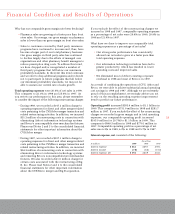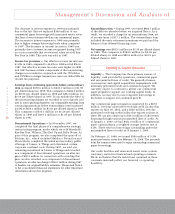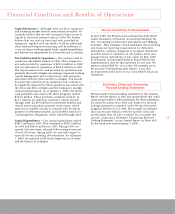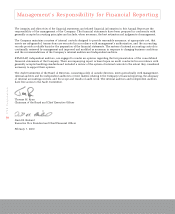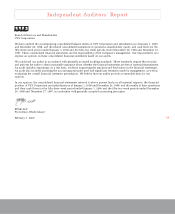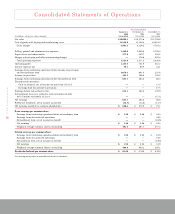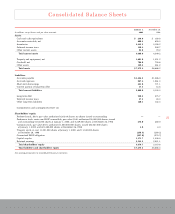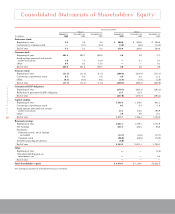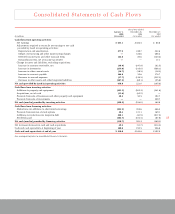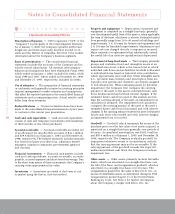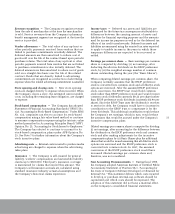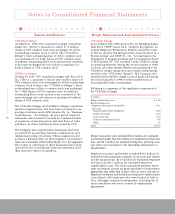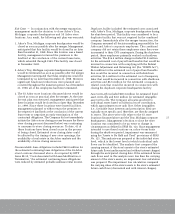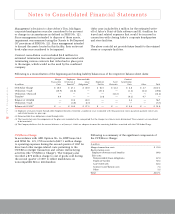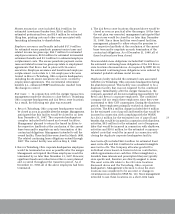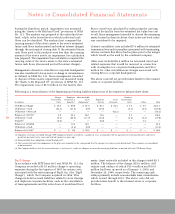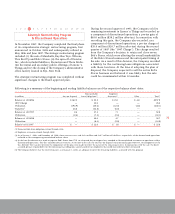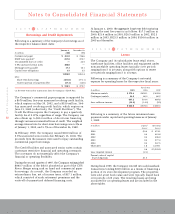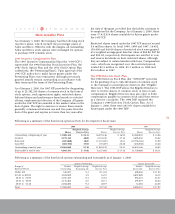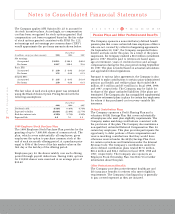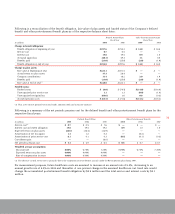CVS 1999 Annual Report Download - page 27
Download and view the complete annual report
Please find page 27 of the 1999 CVS annual report below. You can navigate through the pages in the report by either clicking on the pages listed below, or by using the keyword search tool below to find specific information within the annual report.
25
Revenue recognition ~ The Company recognizes revenue
from the sale of merchandise at the time the merchandise
is sold. Service revenues from the Company’s pharmacy
benefit management segment are recognized at the time the
service is provided.
Vendor allowances ~ The total value of any up-front or
other periodic payments received from vendors that are
linked to purchase commitments is initially deferred. The
deferred amounts are then amortized to reduce cost of
goods sold over the life of the contract based upon periodic
purchase volume. The total value of any up-front or other
periodic payments received from vendors that are not linked
to purchase commitments is also initially deferred. The
deferred amounts are then amortized to reduce cost of goods
sold on a straight-line basis over the life of the related
contract. Funds that are directly linked to advertising
commitments are recognized as a reduction of advertising
expense when the related advertising commitment is satisfied.
Store opening and closing costs ~ New store opening
costs are charged directly to expense when incurred. When
the Company closes a store, the estimated unrecoverable
costs, including the remaining lease obligation, are charged
to expense.
Stock-based compensation ~ The Company has adopted
Statement of Financial Accounting Standards (“SFAS”) No.
123, “Accounting for Stock-Based Compensation.” Under SFAS
No. 123, companies can elect to account for stock-based
compensation using a fair value based method or continue
to measure compensation expense using the intrinsic value
method prescribed in Accounting Principles Board (“APB”)
Opinion No. 25, “Accounting for Stock Issued to Employees.”
The Company has elected to continue to account for its
stock-based compensation plans under APB Opinion No.
25. See Note 7 for further information about the Company’s
stock incentive plans.
Advertising costs ~ External costs incurred to produce media
advertising are charged to expense when the advertising
takes place.
Insurance ~ The Company is self-insured for general
liability, workers’ compensation and automobile liability
claims up to $500,000. Third party insurance coverage
is maintained for claims that exceed this amount. The
Company’s self-insurance accruals are calculated using
standard insurance industry actuarial assumptions and
the Company’s historical claims experience.
Income taxes ~ Deferred tax assets and liabilities are
recognized for the future tax consequences attributable to
differences between the carrying amount of assets and
liabilities for financial reporting purposes and the amounts
used for income tax purposes as well as for the deferred tax
effects of tax credit carryforwards. Deferred tax assets and
liabilities are measured using the enacted tax rates expected
to apply to taxable income in the years in which those
temporary differences are expected to be recovered or
settled.
Earnings per common share ~ Basic earnings per common
share is computed by dividing: (i) net earnings, after
deducting the after-tax dividends on the ESOP preference
stock, by (ii) the weighted average number of common
shares outstanding during the year (the “Basic Shares”).
When computing diluted earnings per common share, the
Company normally assumes that the ESOP preference
stock is converted into common stock and all dilutive stock
options are exercised. After the assumed ESOP preference
stock conversion, the ESOP trust would hold common
stock rather than ESOP preference stock and would receive
common stock dividends (currently $0.23 per share) rather
than ESOP preference stock dividends (currently $3.90 per
share). Since the ESOP Trust uses the dividends it receives
to service its debt, the Company would have to increase its
contribution to the ESOP trust to compensate it for the
lower dividends. This additional contribution would reduce
the Company’s net earnings, which in turn, would reduce
the amounts that would be accrued under the Company’s
incentive compensation plans.
Diluted earnings per common share is computed by dividing:
(i) net earnings, after accounting for the difference between
the dividends on the ESOP preference stock and common
stock and after making adjustments for the incentive
compensation plans by (ii) Basic Shares plus the additional
shares that would be issued assuming that all dilutive stock
options are exercised and the ESOP preference stock is
converted into common stock. In 1997, the assumed
conversion of the ESOP preference stock would have
increased diluted earnings per common share and,
therefore, was not considered.
New Accounting Pronouncements ~ During fiscal 1999,
the Company adopted American Institute of Certified Public
Accountants Statement of Position 98-1, “Accounting for
the Costs of Computer Software Developed or Obtained for
Internal Use.” This statement defines which costs incurred
to develop or purchase internal-use software should be
capitalized and which costs should be expensed. The
adoption of this statement did not have a material effect
on the Company’s consolidated financial statements.


